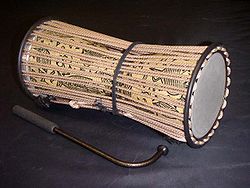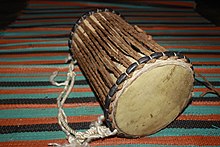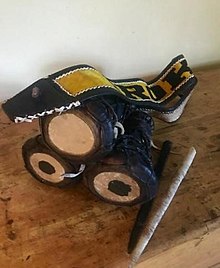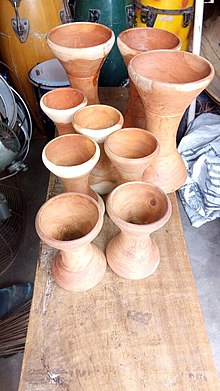
Back Токинг-дръм Bulgarian Tambor parlant Catalan Tama (hudební nástroj) Czech Talking Drum German Tumpaani DGA Parola tamburo Esperanto Tambor parlante Spanish Tama (soitin) Finnish Tama (instrument) French תוף מדבר HE
This article needs additional citations for verification. (April 2009) |
 | |
| Percussion instrument | |
|---|---|
| Other names | Dondo, Odondo, Tamanin, Luca Cappacio, Lunna, Donno, Kalangu, Dan karbi, Igba, Doodo, Tama, Tamma, Gangan |
| Classification | Percussion |
| Hornbostel–Sachs classification | 211.242.11 (Individual double-skin hourglass-shaped drums, one skin used for playing) |
| Developed | Antiquity |


The talking drum is an hourglass-shaped drum from West Africa, whose pitch can be regulated to mimic the tone and prosody of human speech.[1][2][3] It has two drumheads connected by leather tension cords, which allow the player to change the pitch of the drum by scraping the cords between their arm and body.
Originating from the 18th century, talking drum players used tones to disseminate messages, such as news of ceremonies and commands, over 4-5 mile distances.[4]

A skilled player is able to play whole phrases. Most talking drums sound like a human humming depending on the way they are played.

Similar hourglass-shaped drums are found in Asia, but they are not used to mimic conversation, although the idakka is used to mimic vocal music.[5]
Five varieties of dùndún pressure drums of the Yoruba and the atumpan and fontomfrom of the Asante (Ashanti) are especially notable. They send messages up to 20 miles (32 km), where other drummers relay them, quickly spreading news.
- ^ Gershon, Livia (July 27, 2021). "How Does the West African Talking Drum Accurately Mimic Human Speech?". Smithsonian Magazine. Retrieved 4 August 2021.
- ^ Gninyomo, Luc (2021-08-14). "What Is a Talking Drum in Africa?". Sheen Magazine. Retrieved 2023-02-11.
- ^ Cite error: The named reference
:1was invoked but never defined (see the help page). - ^ Cite error: The named reference
:0was invoked but never defined (see the help page). - ^ Jose, Kevin; Chatterjee, Anindya; Gupta, Anurag (2018). "Acoustics of Idakkā: An Indian snare drum with definite pitch". The Journal of the Acoustical Society of America. 143 (5): 3184–3194. Bibcode:2018ASAJ..143.3184J. doi:10.1121/1.5038111. PMID 29857748.